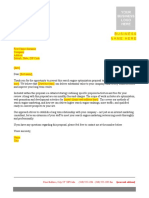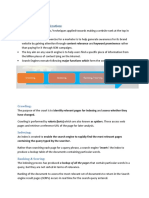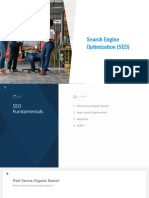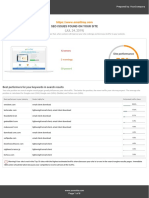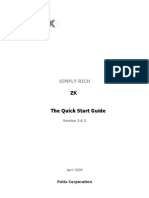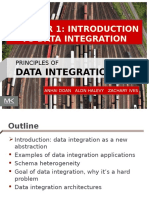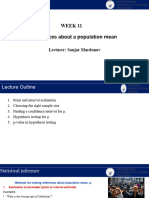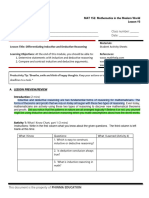100%(1)100% found this document useful (1 vote)
187 viewsImage SEO: The Only Checklist You'll Ever Need: 1. Perform Image Keyword Research
Image SEO: The Only Checklist You'll Ever Need: 1. Perform Image Keyword Research
Uploaded by
santosh kumarCopyright:
© All Rights Reserved
Available Formats
Download as PDF, TXT or read online from Scribd
Image SEO: The Only Checklist You'll Ever Need: 1. Perform Image Keyword Research
Image SEO: The Only Checklist You'll Ever Need: 1. Perform Image Keyword Research
Uploaded by
santosh kumar100%(1)100% found this document useful (1 vote)
187 views5 pagesOriginal Title
Image-SEO-checklist
Copyright
© © All Rights Reserved
Available Formats
PDF, TXT or read online from Scribd
Share this document
Did you find this document useful?
Is this content inappropriate?
Copyright:
© All Rights Reserved
Available Formats
Download as PDF, TXT or read online from Scribd
Download as pdf or txt
100%(1)100% found this document useful (1 vote)
187 views5 pagesImage SEO: The Only Checklist You'll Ever Need: 1. Perform Image Keyword Research
Image SEO: The Only Checklist You'll Ever Need: 1. Perform Image Keyword Research
Uploaded by
santosh kumarCopyright:
© All Rights Reserved
Available Formats
Download as PDF, TXT or read online from Scribd
Download as pdf or txt
You are on page 1of 5
Image SEO:
The Only Checklist
You’ll Ever Need
1. Perform image keyword research
Master the art of identifying high-volume search terms for your images by treating
your images as standalone pieces of content with their own target search term(s).
To find relevant keywords, use Kparser, a keyword suggestion tool that works
specifically for Google Images.
2. Create stand out images that win more attention
and clicks
Avoid using generic stock images. They will kill your site’s EAT (Expertise, Authority,
and Trust) rating. Create “stand out” images that win more attention and clicks by:
Identifying what already ranks.
Checking the search results for your target keyword(s).
Noting down what’s there.
Doing the opposite.
3. Use the right image file type for your material
Choosing the right file type will keep your images looking clear and won’t sacrifice
load time which is critical for SEO. The main image file types are:
GIF – Good for a short animation.
PNG – Good for screenshots of apps and websites with gradients.
JPEG – Good for photos of people, places, or things.
Copyright SEO Sherpa © 2019 | https://seosherpa.com
4. Format your image to optimum proportions
before uploading
Resize the image to the exact width of the space you want to put it in. This will slash
page bloat and improve page load time. Tools you can use to edit your images
include:
Pixlr – A free online tool that works great for minor formatting.
Preview – Standard on all Macs and has everything you need for basic
image editing.
ImageOptim – A free tool for Mac that has “save for web” features.
RIOT – A free image optimizer for Windows.
Photoshop – Great program for its “save for web” option, which helps with
keeping file sizes low without losing quality.
5. Create custom filenames for your images
A custom descriptive filename will improve how search engines rank your images.
When deciding on a filename, choose a name that does these three things:
Describes the image.
Includes your target keyword (refer to step #1).
Is 1-5 words long.
6. Compress the image file for faster load times
Before uploading your image, decrease the weight of your file. This will allow you to
upload lighter images which results in a faster website and higher rankings.
7. Use image ALT text for better image SEO
The image ALT text is the alternative text that appears in place of an image when
the image fails to load. This is used by screen reading tools to help people with
limited eyesight. This also helps search engines better understand the content of
your images.
8. Optimise captions for all images
Captions under images keep users on your page longer and create RankBrain-cen-
tric usability signals. To create great image captions, describe the details of the
photo that are not obvious. These will include things like:
The location.
The time of day or year.
Or, a specific event that is taking place.
Copyright SEO Sherpa © 2019 | https://seosherpa.com
9. Provide valuable information through your
Image Title tag
For your Image Title tag, use a short, descriptive, catchy title that complements the
ALT text.
10. Optimise the content around your image
Follow these four tips to optimise the page your image sits on:
Update your Page Title to include the keyword you are targeting.
Amend the page’s URL to include your target keyword (or a close variation).
Use short, keyword-rich URLs.
Surround your image with relevant text that supports the image content (focus on
context).
11. Include images in your regular XML sitemap
Adding your images to your sitemap will get your images indexed faster and ensure
more of your material gets shown in image search results.
12. Use Scalable Vector Graphics (SVGs)
SVGs are vector graphics and are lighter, faster loading and scale WAY better than
both JPEGs and PNGs. They scale to ANY size with ZERO loss of quality, they can be
animated, and because they load instantly, they’re great for SEO.
13. Optimise your image’s EXIF data
When it comes to EXIF data, do these two things:
Strip out ALL unnecessary EXIF data (so your image is lighter and loads faster).
Tag your up image with relevant EXIF data that’s useful for SEO.
14. Serve responsive images using the code srcset
With the srcset code, you can serve different sizes of images depending on the
screen size used by your user. If you don’t know how to code, WordPress takes care
of the srcset code for you.
Copyright SEO Sherpa © 2019 | https://seosherpa.com
15. Lazy load your images to improve page load speed
Lazy loading will improve your page load time dramatically. Lazy loading requires
some web development skills. If you’re using WordPress, you can use the lazy
loading plugin, LazyLoad.
16. Display social sharing buttons on images
While social media signals do not impact search rankings, when your content gets
shared across social media, it will increase your potential for links and build an
audience for your brand.
17. Use browser caching
Browser caching reduces server requests which speed up page load times. This will
aid user experience and improve SEO.
18. Use a Content Delivery Network
A page using a CDN will load as much 2X faster than a page without one. But, when
you use a CDN, set up a CNAME record so the cached version of your images
continues to provide valuable links and traffic.
19. Display rich snippets with Open Graph
and Twitter Cards
Open Graph tags and Twitter Cards optimise conversation rates and drive a tonne of
traffic to your site. The Open Graph tags you need to maximise CTR are:
og:image
og:title
og:description
20. Standout with schema markup
Using the appropriate structured data will further maximise the effectiveness of
your image SEO and ensure the right image badge appears. This will help users find
relevant content quickly, encouraging better traffic to your site.
Copyright SEO Sherpa © 2019 | https://seosherpa.com
BONUS TIPS:
Properly source your images
If you must use stock images, beware of copyright. Not correctly attributing stock
images to their source can lead to a potential copyright infringement lawsuit. Use
the acronym TASL to appropriately attribute images to their source:
Title: The title of the material.
Author: The author that owns the material.
Source: Where you accessed the material.
License: The CC license being used.
Avoid embedding important text in your images
Adding important texts to your images can negatively impact image SEO. Not every
user can access embedded texts in images. Rather than embedding texts in the
image, provide ALT text in the metadata fields and keep text in HTML.
Interested in getting started?
Let SEO Sherpa help your website
get found first in Google
search results.
BOOK A FREE CONSULTATION
Copyright SEO Sherpa © 2019 | https://seosherpa.com
You might also like
- SEO Expert CVDocument4 pagesSEO Expert CVAhsan MerajNo ratings yet
- Audit Templete by Khalid FarhanDocument11 pagesAudit Templete by Khalid FarhanEmran HossainNo ratings yet
- Seo Proposal Cover LetterDocument1 pageSeo Proposal Cover LetterJohn Andre MarianoNo ratings yet
- Seo Packages: Keywords 10 Keyword 20 Check Mate 40 Check Mate Plus-80 Check Mate Plus-120Document5 pagesSeo Packages: Keywords 10 Keyword 20 Check Mate 40 Check Mate Plus-80 Check Mate Plus-120Anurag SinghNo ratings yet
- SEODocument7 pagesSEOIjazNo ratings yet
- SEO For Beginners: by Marcus Sykes Marcus@websterwebdesign - Co.ukDocument35 pagesSEO For Beginners: by Marcus Sykes Marcus@websterwebdesign - Co.ukashok_bbsrNo ratings yet
- Overseas PDFDocument11 pagesOverseas PDFsantosh kumar100% (1)
- Precalculus: Reference: TC7 by Leithold ©2015Document34 pagesPrecalculus: Reference: TC7 by Leithold ©2015Robert Tac-an NericuaNo ratings yet
- On-Page SEO Optimization GuideDocument2 pagesOn-Page SEO Optimization GuideJunaid MazharNo ratings yet
- SEO ZPH Proposal For Alberdo IndustriesDocument6 pagesSEO ZPH Proposal For Alberdo IndustriesCarlos_CriticaNo ratings yet
- SEO Steps:: Organic On-Page Off-Page PaidDocument6 pagesSEO Steps:: Organic On-Page Off-Page PaidMultiShop BDNo ratings yet
- SEO Proposal For Pakiza - DocxDocument6 pagesSEO Proposal For Pakiza - Docx67Rampur BaghelanNo ratings yet
- SEO Proposal Zera CreativeDocument14 pagesSEO Proposal Zera Creativeja27yaNo ratings yet
- YouTube Automation and Monetization PlanDocument4 pagesYouTube Automation and Monetization Planlapcevic.businessNo ratings yet
- Ecommerce ProposalDocument11 pagesEcommerce ProposalPeter100% (1)
- 17 Point Facebook Ad Checklist NewDocument1 page17 Point Facebook Ad Checklist Newroot dNo ratings yet
- Proposal For Ecommerce WebsiteDocument3 pagesProposal For Ecommerce WebsitejayNo ratings yet
- What We You Do For: 1-Keyword Research and AnalysisDocument2 pagesWhat We You Do For: 1-Keyword Research and AnalysisShabbir AnjumNo ratings yet
- SEO For Beginners 1 3 The Yoast SEO Plugin PDFDocument10 pagesSEO For Beginners 1 3 The Yoast SEO Plugin PDFshainul rizviNo ratings yet
- Web Design Build Questions To Ask New Clients: David Tully Web Designer/DeveloperDocument5 pagesWeb Design Build Questions To Ask New Clients: David Tully Web Designer/DeveloperBuk MarkzNo ratings yet
- Can T Miss Marketing Framework Prompts 1696296031Document12 pagesCan T Miss Marketing Framework Prompts 1696296031madhanarajNo ratings yet
- What Is AI's Role in SEO in 2024Document9 pagesWhat Is AI's Role in SEO in 2024seo.socialnixNo ratings yet
- Digital Marketing PortfolioDocument20 pagesDigital Marketing PortfolioTJ NandaNo ratings yet
- Google Algorithm UpdatesDocument8 pagesGoogle Algorithm UpdatesMalik RayyanNo ratings yet
- Content StrategyDocument15 pagesContent Strategybasel kotbNo ratings yet
- SEO Con - JakartaDocument160 pagesSEO Con - JakartaAldiNo ratings yet
- SEO ProposalDocument5 pagesSEO ProposalAnamNo ratings yet
- Darley Surgical SEO Web ProposalDocument7 pagesDarley Surgical SEO Web ProposalFincera Home Decor PakistanNo ratings yet
- SEO Campaign Checklist - SEO and WebflowDocument15 pagesSEO Campaign Checklist - SEO and WebflowPavleNo ratings yet
- On-Page SEO Guide To Rank On The First Page - 2021 EditionDocument13 pagesOn-Page SEO Guide To Rank On The First Page - 2021 EditionTkNo ratings yet
- SEODocument113 pagesSEOSorin GheorghiuNo ratings yet
- 200+ SEO FactorsDocument6 pages200+ SEO FactorsSony HasanNo ratings yet
- Free SEO Audit ReportDocument8 pagesFree SEO Audit ReportKiyan RoyNo ratings yet
- Technical AuditDocument31 pagesTechnical AuditAroooonNo ratings yet
- SEO ProposalDocument5 pagesSEO ProposalShivdev SaiNo ratings yet
- Ecommerce End To EndDocument7 pagesEcommerce End To EndPravesh mauryaNo ratings yet
- Digital Marketing PortfolioDocument24 pagesDigital Marketing PortfolioAnushka KaushikNo ratings yet
- SEO Implementation ChecklistDocument7 pagesSEO Implementation ChecklistManish Kumar PandeyNo ratings yet
- SmartSites - SEODocument4 pagesSmartSites - SEODK100% (1)
- SEO Cheat Sheet and Checklist5Document4 pagesSEO Cheat Sheet and Checklist5yusufmbubeNo ratings yet
- Create Highranking Content With Chatgpt 3Document23 pagesCreate Highranking Content With Chatgpt 3slurfy2000100% (1)
- Seo PricingDocument2 pagesSeo Pricingfarman aliNo ratings yet
- Portfolio: Mail Us at Visit Us atDocument5 pagesPortfolio: Mail Us at Visit Us atHabeeb RahmanNo ratings yet
- Ecommerce SEO Checklist PDFDocument6 pagesEcommerce SEO Checklist PDFPeriyasamy Thiruvalluvar100% (1)
- CPA Fastbreak BoosterDocument6 pagesCPA Fastbreak BoosterRamadhan Yunus100% (1)
- Instagram AlgoDocument9 pagesInstagram Algoaxce980No ratings yet
- GPTforBusiness Strategic Prompt 240120 185117Document46 pagesGPTforBusiness Strategic Prompt 240120 185117Camilo Aguilar GarcíaNo ratings yet
- White Hat SEO Techniques Ebook PDFDocument12 pagesWhite Hat SEO Techniques Ebook PDFVivek Prajapati0% (1)
- The 10 Essential Components in A Web Design RFPDocument2 pagesThe 10 Essential Components in A Web Design RFPSandee Chriszt WhalenNo ratings yet
- WsCube Tech Paid Ads CourseDocument3 pagesWsCube Tech Paid Ads CourseKD KhanNo ratings yet
- What Is PPC? Learn Everything About PPC AdvertisingDocument6 pagesWhat Is PPC? Learn Everything About PPC AdvertisingAddicted 2 PPCNo ratings yet
- Seo - Audit Report FOR Abc CorporationDocument54 pagesSeo - Audit Report FOR Abc CorporationMd Tanvir AhmedNo ratings yet
- Facebook ReachDocument10 pagesFacebook ReachOussama TebourbiNo ratings yet
- Web Designing Company/Agency in Dubai - Affordable Website Development DubaiDocument7 pagesWeb Designing Company/Agency in Dubai - Affordable Website Development DubaiDelmer GroupNo ratings yet
- I Will Do High Da Guest Posting Da 80 Permanent SEO Dofollow BacklinksDocument12 pagesI Will Do High Da Guest Posting Da 80 Permanent SEO Dofollow Backlinkskhadija attiqNo ratings yet
- 2.1.1 Introduction To Off Page SEODocument23 pages2.1.1 Introduction To Off Page SEOgomajaf572No ratings yet
- Presentation of SEODocument11 pagesPresentation of SEOAkash chandel100% (1)
- Digital Marketing Portfolio - Demiro Ragil SyahDocument18 pagesDigital Marketing Portfolio - Demiro Ragil Syahf8hkm8djnqNo ratings yet
- SEO Tactic - Rank Higher On GoogleDocument14 pagesSEO Tactic - Rank Higher On Googledeepanshu sajwanNo ratings yet
- SEMrush Ranking Factors Study 2 0Document55 pagesSEMrush Ranking Factors Study 2 0rockohealNo ratings yet
- The 7 Point Checklist For Airtight Pipeline ReviewsDocument3 pagesThe 7 Point Checklist For Airtight Pipeline Reviewssantosh kumarNo ratings yet
- Ind Nifty Divid Opp50Document2 pagesInd Nifty Divid Opp50santosh kumarNo ratings yet
- List of Masks Manufacturers 13.04.2020 2Document4 pagesList of Masks Manufacturers 13.04.2020 2santosh kumarNo ratings yet
- Post-Show-Report BengaluruDocument15 pagesPost-Show-Report Bengalurusantosh kumarNo ratings yet
- Msci India Index Inr GrossDocument3 pagesMsci India Index Inr Grosssantosh kumarNo ratings yet
- Eir April2020Document86 pagesEir April2020santosh kumarNo ratings yet
- Comparing Portfolio Rebalancing Strategies YCharts 2021Document10 pagesComparing Portfolio Rebalancing Strategies YCharts 2021santosh kumarNo ratings yet
- Covifor Availability Hospital Details in India, Remdesivir Availability - Hetero HealthcareDocument6 pagesCovifor Availability Hospital Details in India, Remdesivir Availability - Hetero Healthcaresantosh kumarNo ratings yet
- CLG Emotional IntelligenceDocument1 pageCLG Emotional Intelligencesantosh kumarNo ratings yet
- BLANK - Ahrefs On-Page SEO Template - Make A Copy To Edit - 1Document286 pagesBLANK - Ahrefs On-Page SEO Template - Make A Copy To Edit - 1santosh kumar0% (1)
- List of Status Holders As On 13.10.2014Document9 pagesList of Status Holders As On 13.10.2014santosh kumar100% (1)
- Onpage-Seo-Checklist IMPORTANT PDFDocument8 pagesOnpage-Seo-Checklist IMPORTANT PDFsantosh kumar100% (1)
- BLANK - SEMrush On-Page SEO Template - Make A Copy To EditDocument287 pagesBLANK - SEMrush On-Page SEO Template - Make A Copy To Editsantosh kumar0% (1)
- Eir April2016Document391 pagesEir April2016santosh kumarNo ratings yet
- Responsive Email Design Tipsheet: Start SmallDocument3 pagesResponsive Email Design Tipsheet: Start Smallsantosh kumarNo ratings yet
- Certified Digital: & Social Selling SpecialistDocument23 pagesCertified Digital: & Social Selling Specialistsantosh kumarNo ratings yet
- PDDM8 International PDFDocument33 pagesPDDM8 International PDFsantosh kumarNo ratings yet
- We Identified Our Customer Personas: Thoroughly Decently PoorlyDocument2 pagesWe Identified Our Customer Personas: Thoroughly Decently Poorlysantosh kumarNo ratings yet
- Isc 2019 Delegate ListDocument23 pagesIsc 2019 Delegate Listsantosh kumarNo ratings yet
- Our Emails Use Fluid Grids: Thoroughly Decently PoorlyDocument2 pagesOur Emails Use Fluid Grids: Thoroughly Decently Poorlysantosh kumarNo ratings yet
- Our Website Uses Fluid Grids: Thoroughly Decently PoorlyDocument2 pagesOur Website Uses Fluid Grids: Thoroughly Decently Poorlysantosh kumarNo ratings yet
- Responsive Web Design Tipsheet: Start SmallDocument3 pagesResponsive Web Design Tipsheet: Start Smallsantosh kumarNo ratings yet
- Responsify AttractingCustomers-WorkSheet PDFDocument15 pagesResponsify AttractingCustomers-WorkSheet PDFsantosh kumarNo ratings yet
- Inbound Marketing Tipsheet: Use Long-Tail KeywordsDocument3 pagesInbound Marketing Tipsheet: Use Long-Tail Keywordssantosh kumarNo ratings yet
- Workday Human Capital Management: Built For Whatever Comes NextDocument4 pagesWorkday Human Capital Management: Built For Whatever Comes Nextsantosh kumarNo ratings yet
- Why Track Sales Pipeline Velocity? Who Cares? Isn't Pipeline Just A Vanity Metric?Document7 pagesWhy Track Sales Pipeline Velocity? Who Cares? Isn't Pipeline Just A Vanity Metric?santosh kumarNo ratings yet
- 7 Tips To Better Data Management For Retailers W - Aaaa6850Document3 pages7 Tips To Better Data Management For Retailers W - Aaaa6850santosh kumarNo ratings yet
- 7 Tips To Better Data Management For Retailers W - Aaaa6850Document3 pages7 Tips To Better Data Management For Retailers W - Aaaa6850santosh kumarNo ratings yet
- Sem 14 - Pre A1 Adapted PDFDocument4 pagesSem 14 - Pre A1 Adapted PDFRicky EcheverryNo ratings yet
- 03-Carousel Template Kit - Keynote HacksDocument12 pages03-Carousel Template Kit - Keynote HacksSaulo Soares AndradeNo ratings yet
- Mod008 Modal Verbs PDFDocument1 pageMod008 Modal Verbs PDFAnno PizzaNo ratings yet
- Assignment 1Document5 pagesAssignment 1lucawa23031991No ratings yet
- Comp PDFDocument17 pagesComp PDFarjunjr101No ratings yet
- Some Maths Mcqs For Practice.Document6 pagesSome Maths Mcqs For Practice.Sanskriti MishraNo ratings yet
- ZK The Quick Start Guide: Simply RichDocument29 pagesZK The Quick Start Guide: Simply RichVictor Hugo Andrade BautistaNo ratings yet
- Basic Concept of Process Control SystemDocument29 pagesBasic Concept of Process Control Systemhabtemariam mollaNo ratings yet
- DOM Unit 3 QBDocument3 pagesDOM Unit 3 QBRayleighNo ratings yet
- Sean Hannan: Introduction To The Study of Religion Discussion II: Ricoeur's Symbolism of EvilDocument9 pagesSean Hannan: Introduction To The Study of Religion Discussion II: Ricoeur's Symbolism of Evilteachile-1No ratings yet
- Speaking 1 - UpdatedDocument2 pagesSpeaking 1 - UpdatedGloria TianNo ratings yet
- Main-Remote Installation Products Overview (2009)Document40 pagesMain-Remote Installation Products Overview (2009)Denis NonameNo ratings yet
- Data IntegrationDocument38 pagesData IntegrationMohammad Afwan100% (1)
- Reflection Questions (Luke 9.51-62)Document2 pagesReflection Questions (Luke 9.51-62)NewCityChurchCalgaryNo ratings yet
- Successful Sap Abaper RulesDocument3 pagesSuccessful Sap Abaper RulesShiva AnnaldasNo ratings yet
- 1644910852ielts Writing Task 1 - AcademicDocument55 pages1644910852ielts Writing Task 1 - AcademicBurcu Baydemir100% (1)
- Pe12 M4 Social DanceDocument23 pagesPe12 M4 Social Dancekereysha daradalNo ratings yet
- Teacher Name Thouin Course AP Language Date August 20 Lesson Title RhetoricalDocument6 pagesTeacher Name Thouin Course AP Language Date August 20 Lesson Title Rhetoricalcarolinethouin10No ratings yet
- Universidad Politécnica de García Examen de Regularización Especial - Inglés VDocument3 pagesUniversidad Politécnica de García Examen de Regularización Especial - Inglés VAlexa RiveraNo ratings yet
- Week 11 LectureDocument17 pagesWeek 11 LectureOlana SufiyanNo ratings yet
- Mudra - WikipediaDocument55 pagesMudra - Wikipediadevdattmishra410No ratings yet
- Ancient India and ChinaDocument49 pagesAncient India and ChinaNizar AliNo ratings yet
- Ensayo - Mike Bal - NarratologiaDocument2 pagesEnsayo - Mike Bal - NarratologiaCristian GalindrezNo ratings yet
- Sas 03 Mat 152 - FLM v2Document7 pagesSas 03 Mat 152 - FLM v2zurinisaacs503No ratings yet
- B.E. Degree Examinations: Nov / Dec 2010 Fifth Semester Mechatronics EngineeringDocument2 pagesB.E. Degree Examinations: Nov / Dec 2010 Fifth Semester Mechatronics Engineeringdeepakbharathi1994No ratings yet
- Testovi Za Prijemni 2008Document9 pagesTestovi Za Prijemni 2008Алмира ИбричићNo ratings yet
- English File ListeningDocument2 pagesEnglish File ListeningPatricia BaldonedoNo ratings yet
- Linux Interview NotesDocument57 pagesLinux Interview NotesclicknirajNo ratings yet
- How To Pray The RosaryDocument2 pagesHow To Pray The RosaryKaren RodriguezNo ratings yet


